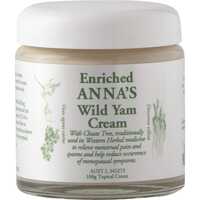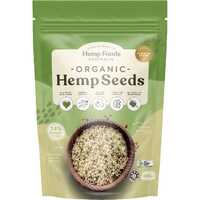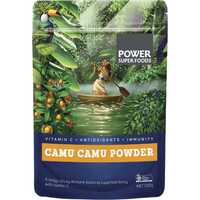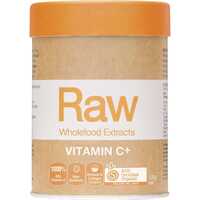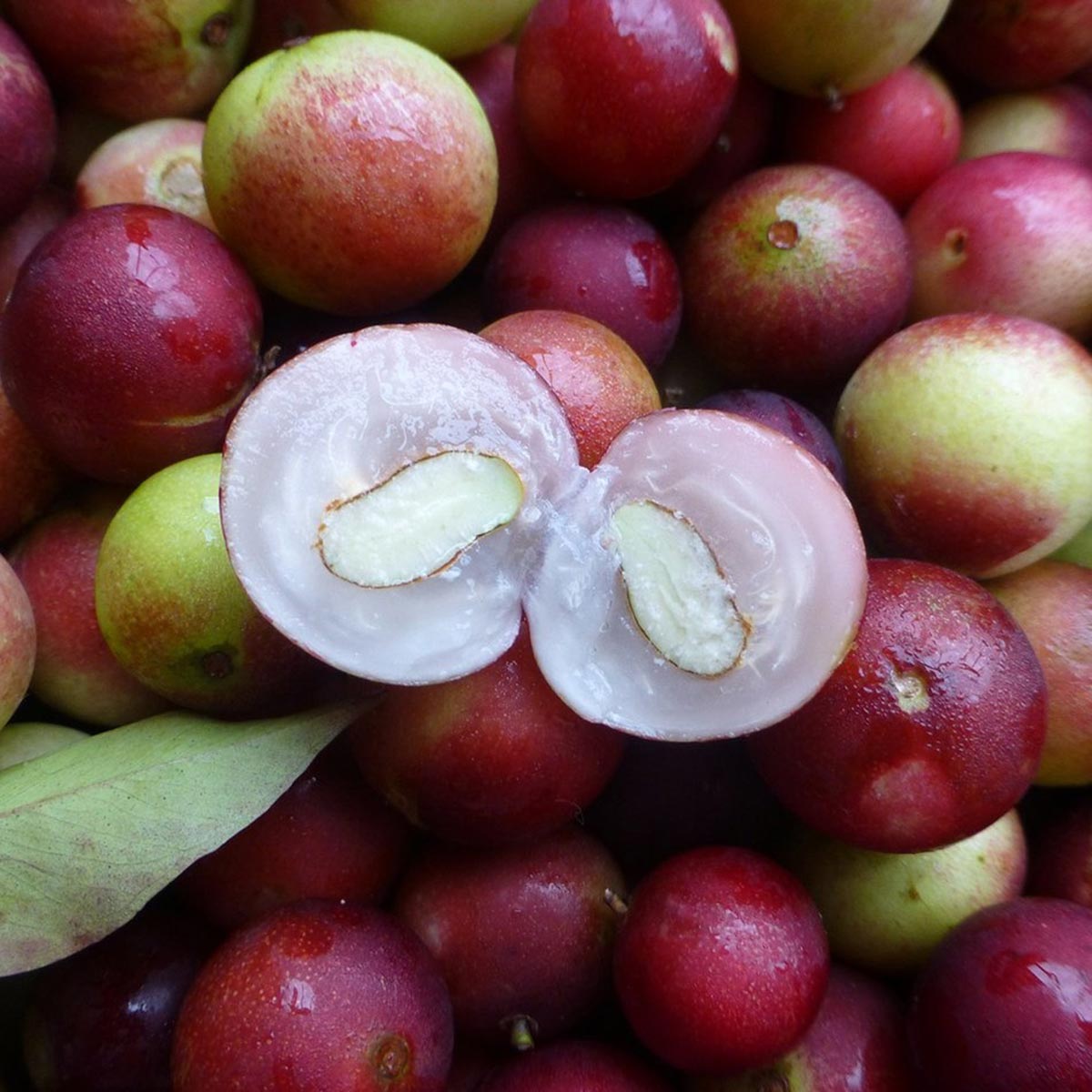A number of exotic foods have gained popularity over recent decades. From spirulina and wheatgrass to acai berries and chia seeds, traditional foods from far-flung corners of the world continue to attract attention. While not as popular as the foods just mentioned, camu camu is a rising star in the health food scene. Grown in the Amazon, this small fleshy fruit delivers a number of health benefits. With more vitamin C than almost anything else on Earth, and lots of powerful antioxidants, this unassuming fruit packs quite a punch.
Let's take a look at camu camu, including its history, nutritional profile, and health benefits. If you want something rich and tangy to supercharge your smoothies or cereal blends, this powerful superfood really does deliver.
What is Camu Camu?
Camu camu, or Myrciaria dubia, is a small bushy tree that grows along riverbanks in the Amazon rainforest. Also known as camu-camu or camocamo, it grows to a height of 3-5 metres and produces small red/purple fruits with yellow flesh. Camu camu has small white flowers, light feathery foliage, and a sweet-smelling aroma. Traditionally, wild camu-camu fruit was harvested along the Amazon riverbank by people in canoes.
This plant is very much a product of the Amazon, growing in the lowland regions of Colombia, Ecuador, Peru, Bolivia, and Brazil. Despite this limited geographic scope, the tree is relatively easy to grow in controlled conditions. Large-scale commercial cultivation and global distribution of camu camu happened fairly recently, however, with Japan being the world's biggest buyer. A large quantity of camu camu still originates from Peru, with exports also coming from Colombia and other South American nations.
History of Camu Camu
Camu camu has a long history of human consumption across the Amazon, where it was used as a food and medicine by a number of native peoples. Amazonian Indians have consumed camu camu for more than 700 years to treat infections, strengthen joints, reduce pain, and promote longevity. According to Mario Pinedo of the Research Institute of the Peruvian Amazon, “People who eat it never get colds.” Many of the benefits of camu camu are attributed to its vitamin C content, which is at least 20 times more than most citrus fruits.
Despite the benefits of this plant, and its long history of human consumption, camu camu was only recently discovered by western markets. There were two primary issues holding it back: the sour and acrid taste of the raw fruit and the inefficient method of handpicked cultivation. Camu camu achieved global popularity in the late 1990s and was discovered by the Japanese market in 2002. By 2007, the value of camu camu exports had reached USD$4.5 million, and despite a few hurdles, it has been popular ever since.
The camu camu market is currently going through a resurgence, as South American plantations streamline production and "superfoods" rise in popularity around the world. Due to its vitamin C content alone, not to mention its antioxidants and immune-boosting properties, camu camu is likely to enjoy even more popularity in the years ahead. While the health benefits of camu camu are clear, and the commercial potential is undeniable, people around the world are just starting to appreciate the wonders of this small Amazonian fruit.
The Nutritional Profile of Camu Camu
Camu camu has a rich nutritional profile, with a powerful combination of vitamins, minerals, carotenoids, and phytochemicals. It also has a great collection of amino acids, including serine, leucine, and valine. Lutein is the dominating carotenoid in camu camu fruit, along with beta-carotene and zeaxanthin. The fruit also contains organic acids like citric acid, isocitric acid, and malic acid, as well as fatty acids such as stearic acid, linoleic acid, and oleic acid.
Camu camu is mostly famous for its vitamin C content, and for very good reason. Not only does it have way more vitamin C than traditional sources like oranges and lemons, but it also has more vitamin C than other superfoods like acerola and acai. Along with vitamin C, camu camu is also a great source of certain minerals, including manganese and copper.
Camu camu has the following nutrients, with DV or Daily Value based on a 2,000 calorie reference diet. 100 grams of camu camu fruit contains:
- 0.4 g of protein
- 0.2 g of fat
- 2,145 mg of vitamin C (3,575% DV)
- 2.1 mg of manganese (106% DV)
- 0.2 mg of copper (10% DV)
- 0.5 mg of iron (3% DV)
- 12.4 mg of magnesium (3% DV)
- 15.7 mg of calcium (2% DV)
- 83.8 mg of potassium (2% DV)
- 0.4 mg of zinc (2% DV)
Health Benefits of Camu Camu
Camu camu offers a number of health benefits, including ultra-high vitamin C content, powerful antioxidants, and immune-boosting compounds. It has been used traditionally to treat a wide variety of conditions and can function as a winter health tonic for busy modern people.
Very high in vitamin C
Above all else, camu camu is known for its high levels of vitamin C. According to Jaime Aguiar, a researcher at the National Institute of Amazonian Research, "Every 100 grams of camu camu has up to 6 grams of vitamin C," which is 100 times greater than the vitamin C content in lemons. Foods high in vitamin C are often recommended during winter to help people avoid colds and flu, with camu camu offering a highly-concentrated source in an easy-to-consume package.
Vitamin C is essential for numerous physiological functions. It helps to strengthen your immune system and plays a central role in the formation of collagen. Vitamin C is also a powerful antioxidant, with regular consumption helping to reduce the oxidative stress linked with numerous chronic conditions. While vitamin C concentrations decrease considerably when foods are stored, camu camu powder is still higher than all other common sources.
Lots of beneficial antioxidants
Along with vitamin C, which itself is a powerful antioxidant, camu camu contains other potent antioxidant compounds like anthocyanins and ellagic acid. These substances help to protect your cells from damage caused by free radicals. When you have too many free radicals in your body, you increase your chances of developing a wide range of chronic conditions, including substantial global problems like heart disease and cancer.
According to one study, adult smokers who consumed camu camu juice daily had significantly lowered oxidative stress and inflammatory markers. Along with its anti-inflammatory action, camu camu has also been associated with protective anti-obesity action, potential protective effect in liver injury, and potential for the prevention of immune-related disease.
Supports your immune system
Camu camu supports a strong immune system, with vitamin C and other compounds helping to fight the common cold and flu among other conditions. Camu camu helps to reduce inflammation and minimise blood sugar spikes, and it also provides protection against harmful bacteria. Chronic inflammation is responsible for numerous conditions, with this fruit shown to suppress inflammation in animal studies.
In South America, camu camu juice and dried powder were used as an emollient cream, with vitamin C and other compounds giving this cream a number of astringent, anti-oxidant, and anti-inflammatory properties. Native Indians also utilised the plant to prevent numerous upper respiratory tract infections. Based on traditional usage, camu camu is believed to protect the heart from atherosclerosis, protect the skin from sun damage, and even delay the aging process.
How to use Camu Camu
Camu camu is a small fruit roughly the size of a cherry. The skin has a red/purple colour when ripe, and the flesh is an appealing yellow. While the fruit can be eaten raw or made into juice, it has a rather sour taste that can take some getting used to. Camu camu fruits can also be hard to purchase in the west, with powder products much more readily available. There are lots of fantastic camu camu products on the market, including pure camu camu powder and nutritious powdered blends that mix camu camu with other beneficial ingredients.
Juices, smoothies, and meals, including savoury dishes, salads, and sweet muesli and yogurt dishes can be mixed with camu camu powder. The powder is available to purchase, simple to measure, and easy to combine with other flavours to make the taste more palatable. However you consume camu camu, it's important to avoid excessive heat to preserve the nutrients. Vitamin C is particularly susceptible to heat, so try to avoid cooking, and eat your camu camu at room temperature.
If you want to experience the wonders of camu camu for yourself, Healthy Being has a number of great products to choose from. Like many of our other products, the camu camu powder we stock is organic, vegan, and keto-friendly. Our camu camu products have a delicious tangy flavour, which makes them great with cereals, smoothies, and numerous other dishes. For high-quality camu camu and other superfood products, check out our website today!


 Certified Organic
Certified Organic Vegan Friendly
Vegan Friendly  Vegetarian
Vegetarian Organic Ingredients
Organic Ingredients Dairy Free
Dairy Free Gluten Free
Gluten Free Keto Friendly
Keto Friendly

















